MITSUBISHI I-MIEV 2011 User Guide
Manufacturer: MITSUBISHI, Model Year: 2011, Model line: I-MIEV, Model: MITSUBISHI I-MIEV 2011Pages: 193, PDF Size: 12.2 MB
Page 11 of 193
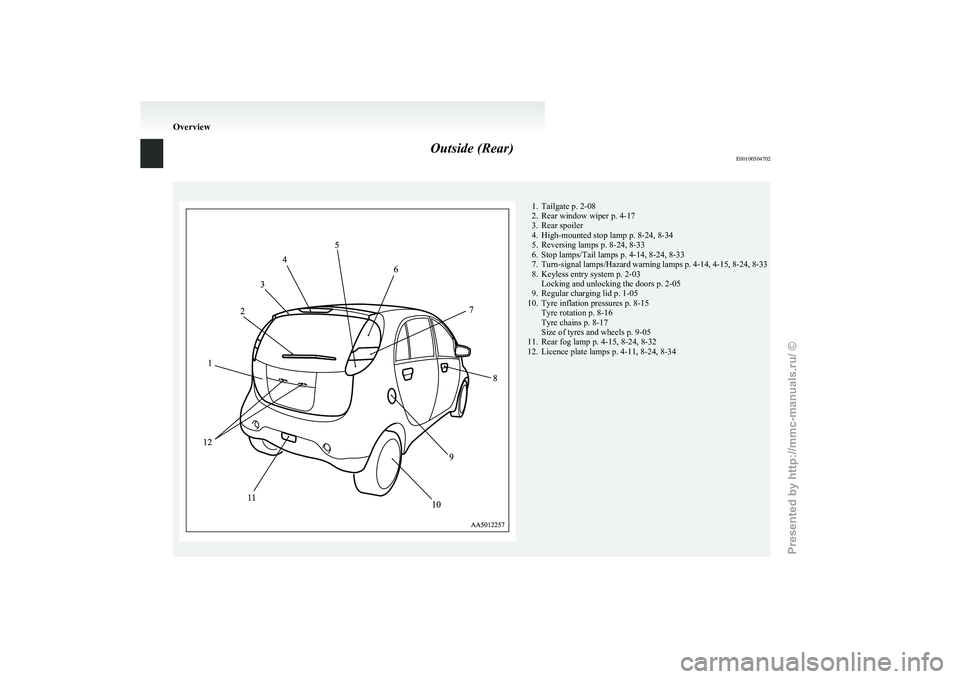
Outside (Rear)
E00100504702 1. Tailgate p. 2-08
2.
Rear window wiper p. 4-17
3. Rear spoiler
4. High-mounted stop lamp p. 8-24, 8-34
5. Reversing lamps p. 8-24, 8-33
6. Stop lamps/Tail lamps p. 4-14, 8-24, 8-33
7. Turn-signal lamps/Hazard warning lamps p. 4-14, 4-15, 8-24, 8-33
8. Keyless entry system p. 2-03 Locking and unlocking the doors p. 2-05
9. Regular charging lid p. 1-05
10. Tyre inflation pressures p. 8-15 Tyre rotation p. 8-16
Tyre chains p. 8-17
Size of tyres and wheels p. 9-05
11. Rear fog lamp p. 4-15, 8-24, 8-32
12. Licence plate lamps p. 4-11, 8-24, 8-34 Overview
Presented by http://mmc-manuals.ru/ \251
Page 12 of 193

Familiarizing yourself with i-MiEV
................................................02
Installation of accessories ................................................................ 03
Modification/alterations to the electrical systems
............................04
Genuine parts................................................................................... 04
Disposal information for used batteries ...........................................04
Cautions and actions to deal with intense heat ................................05
Cautions and actions to deal with intense cold ................................06General information
Presented by http://mmc-manuals.ru/ \251
Page 13 of 193

Familiarizing yourself with
i-MiEV E00202600016
This
section describes features that the i-MiEV has
as an electric vehicle and gives precautions that
you should observe. It is important. Please read it
carefully.
Main features E00202700017
l Energy
required for driving is only electrici-
ty and fuel supply is not required.
l The traction battery and electric motor unit
are mounted outside the passenger compart-
ment. In this way, passenger space is ob-
tained for riding of four adults.
l With the high performance motor, noise and
vibration during driving are greatly limited
and powerful acceleration can also be ob-
tained.
l With regenerative braking, the traction bat-
tery is automatically charged when the accel-
erator is released.
l The vehicle can be charged from general pow-
er outlets (rated AC 220-240 V).
l Charge with the quick charger for i-MiEV is
also available.
l The creeping behaviour occurs in i-MiEV
like a vehicle with automatic transmission.
Regenerative braking
It is equivalent to engine braking of an engine vehi-
cle. If you step off the accelerator pedal during driv-
ing, motion energy is converted into electric energy
using the motor as a power generator.
In this conversion, braking force is generated and
converted electric energy is charged in the traction
battery. Regenerative braking is stronger in the order of the
selector
lever position of “C” (COMFORT), “D”
(DRIVE), “B” (BRAKE).
Put the selector lever to the “B” (BRAKE) or “C”
(COMFORT) position according to the driving con-
dition.
“B”: Strong regenerative braking (For downhill)
“C”: Weak regenerative braking (For long cruising)
Traction battery E00202800018
l It
is the battery to operate the motor (electric
motor unit) and the air conditioning.
In addition to the traction battery, i-MiEV
has the auxiliary battery to operate lamps, wip-
ers, etc.
l Compact, light-weight lithium ion battery
with high energy density is used for the trac-
tion battery.
l The lithium ion battery has the following char-
acteristics. Please read this carefully and
treat the battery paying attention to the fol-
lowing:
Characteristics l It is not necessary to consume the battery com-
pletely before charging.
l The capacity is gradually degraded depend-
ing on time used and operating conditions.
l The performance may be changed due to the
outside temperature. At low temperature, in
particular, the cruising range is short and the
charging time is long, compared to operation
at normal temperature.
l If you store your vehicle at an extremely
high or low temperature, the battery capacity
may be lowered.
l The battery is gradually discharged without
use and the battery charge is lowered. Precautions for operation
l Do
not store your vehicle with the energy lev-
el gauge showing 0 bars.
Doing so could damage the traction battery.
The battery may have to be replaced depend-
ing on the low capacity.
l If you do not use your vehicle for a long
time, please charge the traction battery to the
full every 3 months so that the energy level
gauge may not be 0 bars.
l MITSUBISHI MOTORS collects traction bat-
teries. If you scrap your vehicle, please con-
sult a MITSUBISHI MOTORS Authorized
Service Point.
NOTE l The progress of the battery capacity loss de-
pends on the vehicle usage and the environ-
ment.
We recommend to do regular charging from
2 bars or less to charge completely at least
once in 3 months.
The procedure lets the battery remaining indi-
cator adjusted automatically.
Cruising range E00202900019
l Even
if the charge level is the same, the cruis-
ing range may vary depending on the driving
conditions. Since driving at high speed or
climbing on a hill requires higher consump-
tion of the traction battery than usual, the
cruising range is shortened.
l Since the air conditioning (cooling or heat-
ing) consumes power of the traction battery,
its operation results in a shorter cruising
range. Maintain an appropriate temperature. General information
02
Presented by http://mmc-manuals.ru/ \251
Page 14 of 193
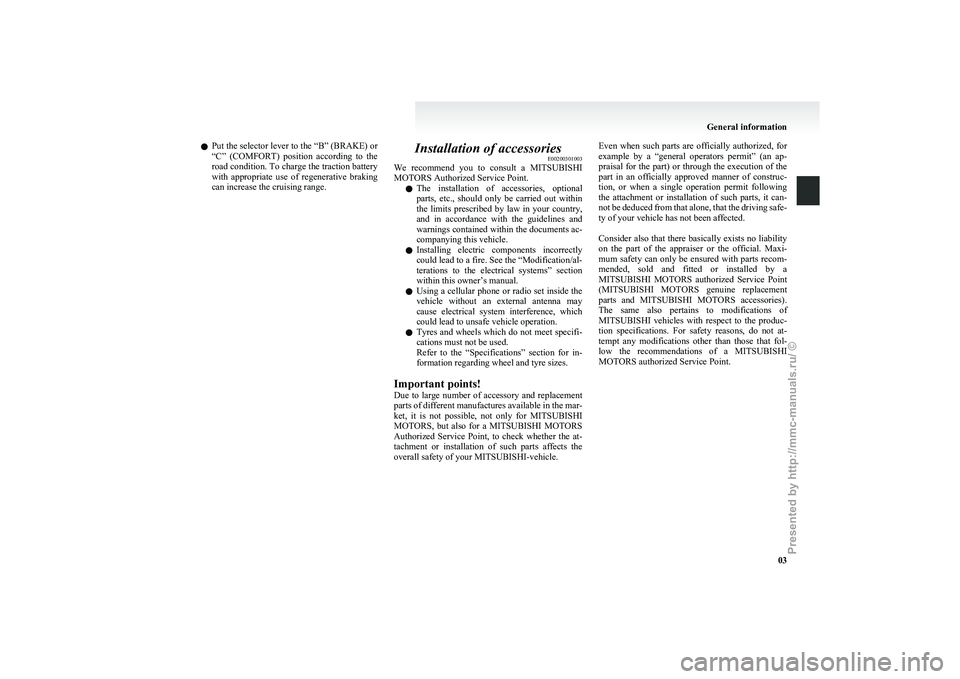
l
Put the selector lever to the “B” (BRAKE) or
“C” (COMFORT) position according to the
road condition. To charge the traction battery
with appropriate use of regenerative braking
can increase the cruising range. Installation of accessories
E00200301003
We
recommend you to consult a MITSUBISHI
MOTORS Authorized Service Point.
l The installation of accessories, optional
parts, etc., should only be carried out within
the limits prescribed by law in your country,
and in accordance with the guidelines and
warnings contained within the documents ac-
companying this vehicle.
l Installing electric components incorrectly
could lead to a fire. See the “Modification/al-
terations to the electrical systems” section
within this owner’s manual.
l Using a cellular phone or radio set inside the
vehicle without an external antenna may
cause electrical system interference, which
could lead to unsafe vehicle operation.
l Tyres and wheels which do not meet specifi-
cations must not be used.
Refer to the “Specifications” section for in-
formation regarding wheel and tyre sizes.
Important points!
Due to large number of accessory and replacement
parts of different manufactures available in the mar-
ket, it is not possible, not only for MITSUBISHI
MOTORS, but also for a MITSUBISHI MOTORS
Authorized Service Point, to check whether the at-
tachment or installation of such parts affects the
overall safety of your MITSUBISHI-vehicle.
Even when such parts are officially authorized, for
example
by a “general operators permit” (an ap-
praisal for the part) or through the execution of the
part in an officially approved manner of construc-
tion, or when a single operation permit following
the attachment or installation of such parts, it can-
not be deduced from that alone, that the driving safe-
ty of your vehicle has not been affected.
Consider also that there basically exists no liability
on the part of the appraiser or the official. Maxi-
mum safety can only be ensured with parts recom-
mended, sold and fitted or installed by a
MITSUBISHI MOTORS authorized Service Point
(MITSUBISHI MOTORS genuine replacement
parts and MITSUBISHI MOTORS accessories).
The same also pertains to modifications of
MITSUBISHI vehicles with respect to the produc-
tion specifications. For safety reasons, do not at-
tempt any modifications other than those that fol-
low the recommendations of a MITSUBISHI
MOTORS authorized Service Point. General information
03
Presented by http://mmc-manuals.ru/ \251
Page 15 of 193
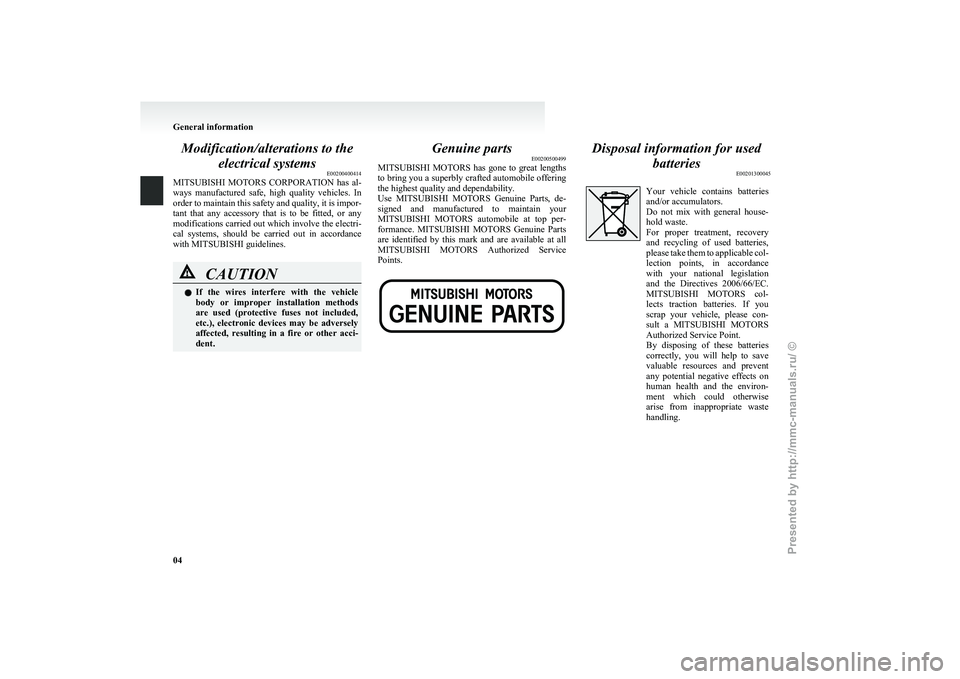
Modification/alterations to the
electrical systems E00200400414
MITSUBISHI MOTORS
CORPORATION has al-
ways manufactured safe, high quality vehicles. In
order to maintain this safety and quality, it is impor-
tant that any accessory that is to be fitted, or any
modifications carried out which involve the electri-
cal systems, should be carried out in accordance
with MITSUBISHI guidelines. CAUTION
l
If
the wires interfere with the vehicle
body or improper installation methods
are used (protective fuses not included,
etc.), electronic devices may be adversely
affected, resulting in a fire or other acci-
dent. Genuine parts
E00200500499
MITSUBISHI MOTORS
has gone to great lengths
to bring you a superbly crafted automobile offering
the highest quality and dependability.
Use MITSUBISHI MOTORS Genuine Parts, de-
signed and manufactured to maintain your
MITSUBISHI MOTORS automobile at top per-
formance. MITSUBISHI MOTORS Genuine Parts
are identified by this mark and are available at all
MITSUBISHI MOTORS Authorized Service
Points. Disposal information for used
batteries E00201300045 Your vehicle contains batteries
and/or accumulators.
Do
not mix with general house-
hold waste.
For proper treatment, recovery
and recycling of used batteries,
please take them to applicable col-
lection points, in accordance
with your national legislation
and the Directives 2006/66/EC.
MITSUBISHI MOTORS col-
lects traction batteries. If you
scrap your vehicle, please con-
sult a MITSUBISHI MOTORS
Authorized Service Point.
By disposing of these batteries
correctly, you will help to save
valuable resources and prevent
any potential negative effects on
human health and the environ-
ment which could otherwise
arise from inappropriate waste
handling. General information
04
Presented by http://mmc-manuals.ru/ \251
Page 16 of 193
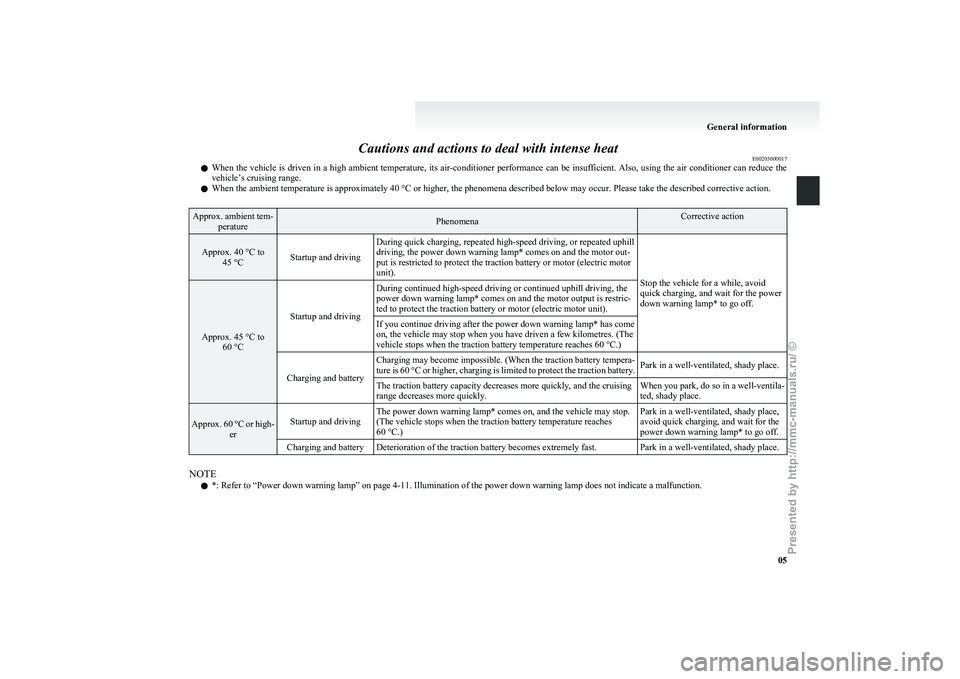
Cautions and actions to deal with intense heat
E00203000017
l When
the vehicle is driven in a high ambient temperature, its air-conditioner performance can be insufficient. Also, using the air conditioner can reduce the
vehicle’s cruising range.
l When the ambient temperature is approximately 40 °C or higher, the phenomena described below may occur. Please take the described corrective action. Approx. ambient tem-
perature Phenomena Corrective action
Approx. 40 °C to
45 °C Startup and driving During quick charging, repeated high-speed driving, or repeated uphill
driving, the power down warning lamp* comes on and the motor out-
put is restricted to protect the traction battery or motor (electric motor
unit).
Stop the vehicle for a while, avoid
quick charging, and wait for the power
down warning lamp* to go off.Approx. 45 °C to
60 °C Startup and driving
During continued high-speed driving or continued uphill driving, the
power down warning lamp* comes on and the motor output is restric-
ted to protect the traction battery or motor (electric motor unit).
If you continue driving after the power down warning lamp* has come
on, the vehicle may stop when you have driven a few kilometres. (The
vehicle stops when the traction battery temperature reaches
60 °C.)
Charging and battery Charging may become impossible. (When the traction battery tempera-
ture
is 60 °C or higher, charging is limited to protect the traction battery. Park in a well-ventilated, shady place.
The traction battery capacity decreases more quickly, and the cruising
range decreases more quickly. When you park, do so in a well-ventila-
ted, shady place.Approx. 60 °C or high-
er Startup and driving
The power down warning lamp* comes on, and the vehicle may stop.
(The vehicle stops when the traction battery temperature reaches
60 °C.) Park in a well-ventilated, shady place,
avoid quick charging, and wait for the
power down warning lamp* to go off.
Charging and battery Deterioration of the traction battery becomes extremely fast. Park in a well-ventilated, shady place. NOTE
l *: Refer to “Power down warning lamp” on page
4-11. Illumination of the power down warning lamp does not indicate a malfunction. General information
05
Presented by http://mmc-manuals.ru/ \251
Page 17 of 193
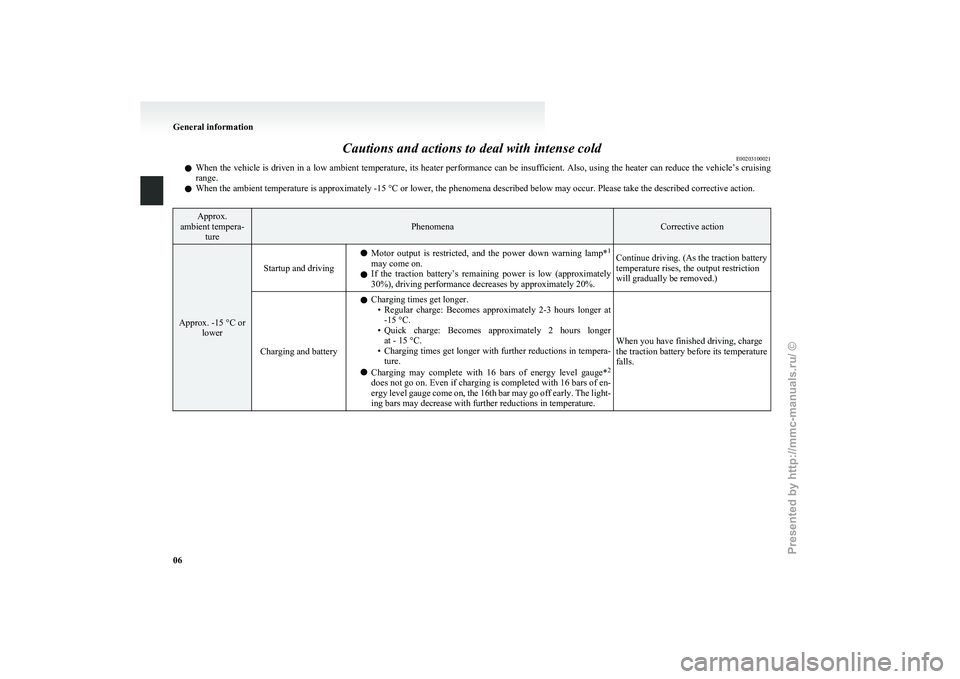
Cautions and actions to deal with intense cold
E00203100021
l When
the vehicle is driven in a low ambient temperature, its heater performance can be insufficient. Also, using the heater can reduce the vehicle’s cruising
range.
l When the ambient temperature is approximately -15 °C or lower, the phenomena described below may occur. Please take the described corrective action. Approx.
ambient tempera- ture Phenomena Corrective action
Approx. -15 °C or
lower Startup and driving
l
Motor
output is restricted, and the power down warning lamp* 1
may come on.
l If the traction battery’s remaining power is low (approximately
30%), driving performance decreases by approximately 20%. Continue driving. (As the traction battery
temperature rises, the output restriction
will gradually be removed.)
Charging and battery l
Charging times get longer.
• Regular
charge: Becomes approximately 2-3 hours longer at
-15 °C.
• Quick charge: Becomes approximately 2 hours longer at - 15 °C.
• Charging times get longer with further reductions in tempera- ture.
l Charging may complete with 16 bars of energy level gauge* 2
does not go on. Even if charging is completed with 16 bars of en-
ergy level gauge come on, the 16th bar may go off early. The light-
ing bars may decrease with further reductions in temperature. When you have finished driving, charge
the traction battery before its temperature
falls.General information
06
Presented by http://mmc-manuals.ru/ \251
Page 18 of 193
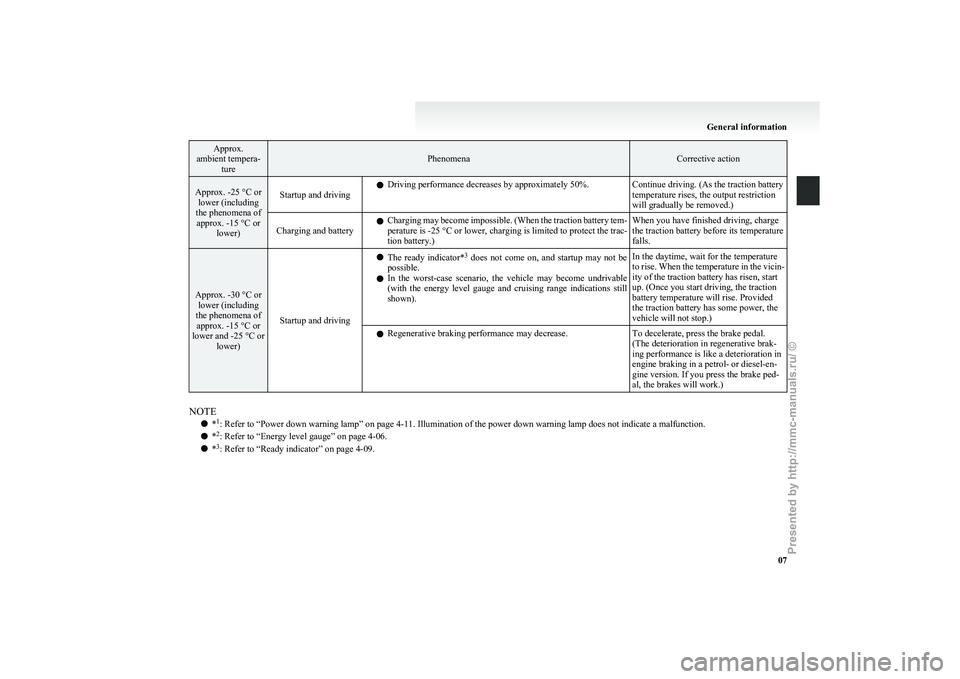
Approx.
ambient tempera- ture Phenomena Corrective action
Approx. -25 °C or
lower (including
the phenomena of approx. -15 °C or lower) Startup and driving
l
Driving performance decreases by approximately 50%. Continue driving. (As the traction battery
temperature rises, the output restriction
will gradually be removed.)
Charging and battery l
Charging
may become impossible. (When the traction battery tem-
perature is -25 °C or lower, charging is limited to protect the trac-
tion battery.) When you have finished driving, charge
the traction battery before its temperature
falls.Approx. -30 °C or
lower (including
the phenomena of approx. -15 °C or
lower and -25 °C or lower) Startup and driving l
The
ready indicator* 3
does not come on, and startup may not be
possible.
l In the worst-case scenario, the vehicle may become undrivable
(with the energy level gauge and cruising range indications still
shown). In the daytime, wait for the temperature
to
rise. When the temperature in the vicin-
ity of the traction battery has risen, start
up. (Once you start driving, the traction
battery temperature will rise. Provided
the traction battery has some power, the
vehicle will not stop.)
l Regenerative braking performance may decrease.
To decelerate, press the brake pedal.
(The deterioration in regenerative brak-
ing performance is like a deterioration in
engine braking in a petrol- or diesel-en-
gine version. If you press the brake ped-
al, the brakes will work.)NOTE
l *1
: Refer to “Power down warning lamp” on page
4-11. Illumination of the power down warning lamp does not indicate a malfunction.
l *2
: Refer to “Energy level gauge” on page 4-06.
l *3
: Refer to “Ready indicator” on page 4-09. General information
07
Presented by http://mmc-manuals.ru/ \251
Page 19 of 193

Presented by http://mmc-manuals.ru/ \251
Page 20 of 193
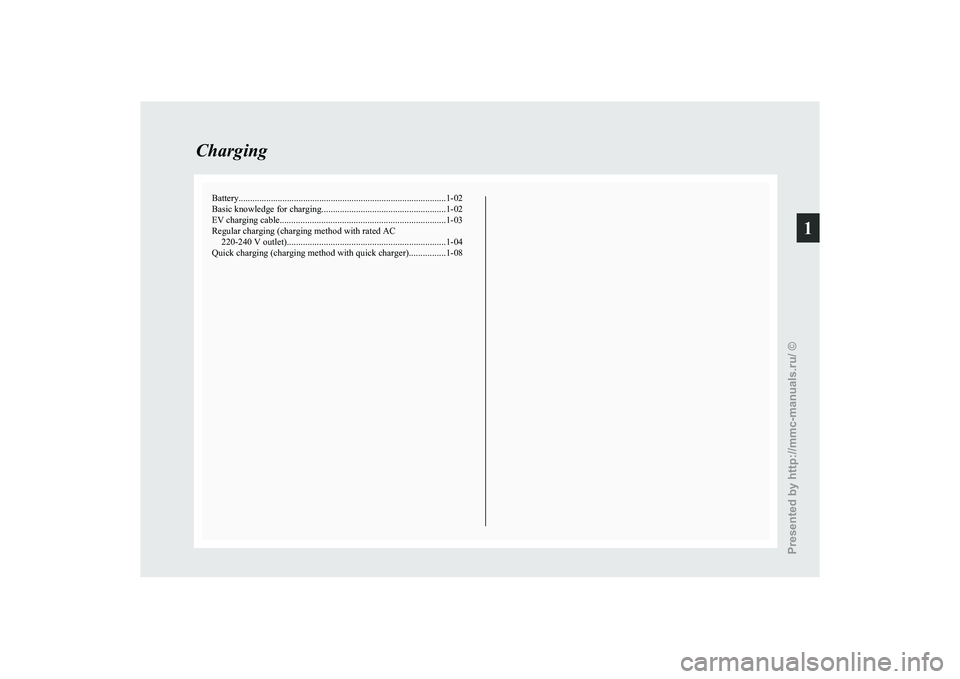
Battery
.......................................................................................... 1-02
Basic knowledge for charging ...................................................... 1-02
EV charging cable ........................................................................ 1-03
Regular charging (charging method with rated AC 220-240 V outlet)..................................................................... 1-04
Quick charging (charging method with quick charger) ................1-08 Charging
1
Presented by http://mmc-manuals.ru/ \251